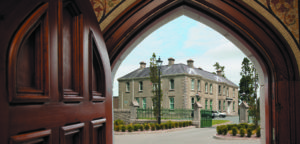HOMILY GIVEN BY
CARDINAL SEÁN BRADY
SATURDAY 4 APRIL 2009
We are here today to celebrate the 50th anniversary of the official opening of this magnificent Church of Our Lady of Lourdes 50 years ago for on 5 April 1959 this Church was dedicated to the praise and glory of God by Cardinal John D’Alton. On that day the Mayor, Councillor Eugene Hughes, and the members of the Corporation processed in their beautiful robes to the opening ceremony. Cardinal D’Alton was escorted by canopy bearers and a Scouts Guard of Honour.
The architect, Simon Aloysius Leonard, of the firm W. H. Byrne, Architects, Dublin had been planning this new church along with Mgr Stokes for years. The tender of Creedon Construction for £132,000 had been accepted in 1956 and the length of the building was set as two years.
The decision to build a new church was taken for two reasons:
1. The condition of the original church – The Chapel of Ease at Hardman’s Gardens had deteriorated seriously.
2. Expansion of the town, in this area, Bothar Brua, Pearse Park and Yellowbatter Ascal needed a larger church. People wanted a house of prayer and a place of worship to meet their needs
I reckon the choice of name was determined by the centenary, in 1958, of the Apparition of Our Lady to Saint Bernadette at Lourdes. So it was placed under the patronage of our Lady of Lourdes.
Some of you will remember the Sales of Work and the Carnivals to raise the funds. Others will recall the search for donors. Their donations are listed in the Commemoration booklet and are acknowledged on the plaques. The brochure says that Monsignor had a keen appreciation of the requirement for money to finance his capital projects. Donors were found for each of the 84 pews on which you sit and for the windows, rails and altars as well as the Mortuary Chapel and the Baptistery. Then there was the Golden Book which included a contribution from one Senator John F Kennedy of Boston, Massachusetts. It is no wonder Monsignor Stokes was conferred with the freedom of the Borough of Drogheda.
About 15,500 people gave a minimum of £1 each to the construction of this wonderful Church, dedicated to Mary, the Mother of Jesus and our Mother also. That in itself must have given to the people of this area, of this town, of this parish, a great sense of ownership – a great feeling of pride and satisfaction. Yes, it was the House of God – the House of Prayer – but it was also the House of the Faith of the People of Drogheda.
Today I congratulate you, and your parents and grandparents, on all of that. I congratulate everyone associated with producing the lovely booklet which captures so well, in words and photographs, the atmosphere of that wonderful weekend.
We are gathered here this evening to thank God for all of that. I am very happy to be joined in this celebration by so many priests – native sons of the parish, priests who formerly ministered here and by priests ministering here in Drogheda at present. I recall also the fact that Bishop Austin Quinn and Bishop James Lennon were here at the opening.
As we look to the past, we also contemplate the present and keep an eye on the future. The Catholic population of this parish is now estimated at 15,500, the same number as contributed £1 or more to the original church. Then there are almost 2,000 in the parish of Mell. There were big challenges facing Mgr Stokes and his companions. They faced them and they succeeded.
There are big challenges facing us today but challenges of a different kind. The challenge today is to build the faith of the Catholic community and to re-build it where it has deteriorated. These challenges must be addressed and they too can be managed. The challenge is for us to go and make disciples of each and every one of these people. Each and every one is made in the image and likeness of God. Each and every one has been purchased by the saving blood of Jesus Christ. Each and every one of us is to play our part.
We are celebrating the Year of St. Paul – a year called to mark the 2,000th anniversary of his birth. The Second Reading this evening is from St. Paul. He tells us “let this mind be in you which was in Christ, Jesus”, for the attitude which we should have is the one which Jesus had. Jesus always had the nature of God but he did not think that he should try and remain equal to God. Jesus didn’t jealously hold on to the glory that was his by right. Instead, he emptied himself; he made himself powerless as a slave is powerless. He gave up all he had and took the nature of a servant. He was humble and he walked a way of obedience -all the way to death on a cross. His attitude was that he put others first and thought others before himself.
If we are lead others to Christ, we ourselves must first find Christ in our own lives. We must try to be like him. We must have the same attitude. We normally think of saving our own skins first. This was not the way Jesus thought.
Here in this Church of Our Lady of Lourdes I am reminded of the example of St Bernadette. After Our Lady had appeared to Bernadette, she entered the convent and became a nun. She could have reasonably expected to have been be left in Lourdes to gives talks to pilgrims and to generally promote the shrine. But not at all, she was asked to transfer to a convent in Nevers which was a long distance from Lourdes. I am not sure if she ever came back. Bernadette obeyed because she believed that that was what God wanted her to do. She made a big sacrifice but today she is a great saint in Heaven because she did not try to seek out her own interests, but she obeyed what her superiors asked of her.
Today is the Foundation Day of the Medical Missionary of Mary. We rejoice in the news of the election of their new Congregational Leader, Sister Siobhan Corkery and we pray God’s blessing upon her and her newly-elected Council.
The Medical Missionaries became great by having the attitude of Christ. They too became great by giving up all that they had and answering God’s call to become medical missionaries in faraway Africa. They answered the call by, first of all, forgetting themselves and their own self-interest. They thought first of the good of the African people and of the advantages which the Good News of the Gospel could bring to Africa.
Today the mission territories are nearer home. All of those 15,500 people are part of the Body of Christ by baptism. Christ said: “Whatsoever you do to the least of my brethren you do to me”. It is interesting to see the different ways the Body of Christ is treated in Mark’s account of the passion.
First of all we have the fact that it was anointed by a woman with an alabaster jar full of a very expensive perfume made of pure nard. Some people ridiculed the idea and criticized her harshly. For them it was a waste of good perfume. “It could have been given to the poor” they said. But Jesus defends her action robustly. They could help the poor any time they liked. They could not always prepare her body for burial. She had done a fine and beautiful thing. She had shown great and devout respect for the body of Christ.
Mercy – compassion – this will be the quality on which we will all be judged at the final judgement. One of the earliest writers in the Church went so far as to say that “those who have no mercy will be condemned”. Traditionally these demands of the Gospel have been handed down to us as the corporal and spiritual works of mercy. They are the kind of works that should characterize the life of every follower of Christ.
The corporal works of mercy require us to feed the hungry; give drink to the thirsty; clothe the naked; shelter the homeless; care for the sick; visit those in prison and bury the dead. Tomorrow in Armagh we will be remembering the ‘Disappeared’ whose bodies have not received Christian burial. Today’s Gospel indicates the care taken to make sure that the dead body of Christ got a respectful burial.
I am sure that over the past 50 years many followers of Christ went out from this Church to carry out those same corporal works of mercy. They would have been inspired to do so by the words of God which they heard here. They would have been empowered by the Bread of Life which they received here.
Over the next fifty years may Mary help us all to continue to do so.
May Mary, Our Lady of Lourdes, Mother of Hope accompany us on that journey. May she teach us to proclaim the Living God,
Help us to bear witness to Jesus, the one Saviour.
May she make us kindly to our neighbours,
welcoming to the needy,
Concerned for justice,
impassioned builders of a more just world.
Our Lady of Lourdes, intercede for us
As we carry out our work in history,
Certain that the Father’s plan will be fulfilled.
AMEN



You must be logged in to post a comment.